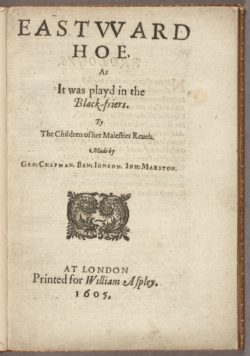<em>Eastward Ho!</em>
Eastward Ho! is not only a successful comedy in its own right but also an unusually successful example of collaborative playwriting among three experienced writers: Marston, Chapman and Jonson. My edition will be something of an anomaly in the Marston project, since I don’t propose to re-edit the text. Suzanne Gossett has already done this, admirably, for the Cambridge Ben Jonson and her text will be the basis for mine. However, the play is bound to look very different in the context of Marston’s career, and this is what I shall focus on in my introduction and notes.
As is well known, the play angered at least one of the king’s Scottish followers and two of the authors were imprisoned as a result. All three authors had already had problems with the authorities, but Marston is the only one whose (poetic and satiric) works had actually been burnt in public, so it seems odd that he is the one who got away. Did he just happen to be out of town, was he tipped off about the forthcoming arrests, or did he somehow manage to convince the authorities that the subversive parts of the play had nothing to do with him? As the play now stands, it contains only a couple of potentially offensive passages, but the text shows evidence of censorship, or self-censorship, some of which went on during the printing process.
Most of those who have studied Eastward Ho! recently have tried to pick it apart, looking for evidence of ideological differences among the authors. As Suzanne Gossett has suggested elsewhere, Marston does not seem to have been the ideal collaborator, yet he had also been involved with Jonson and Chapman in writing the poems that appeared as an appendix to Love’s Martyr in 1601 (and which included a poem by Shakespeare). Chapman’s apologetic letter to the Lord Chamberlain claims that the play was ‘so much importuned’ that there was no time to get official approval; perhaps collaboration was a way of fulfilling the theatrical demand more quickly. I expect to consider the ways in which the three collaborators created a work that feels so remarkably homogenous.
The performance history of Eastward Ho! suggests that it has always given pleasure in the theatre. Helping readers to enjoy it on the page will involve explaining some of its rich contexts: the boys’ acting company for which it was written; the customs of the City of London and its trade guilds; contemporary stereotypes about court and City; and the transitional period that followed the accession of James I (with further stereotypes about the Scots and the earliest overseas colonial projects). It will be still more important, however, to provide annotation that does justice to the complicated plot and keeps the dialogue from becoming mired in its own witty topicality.

